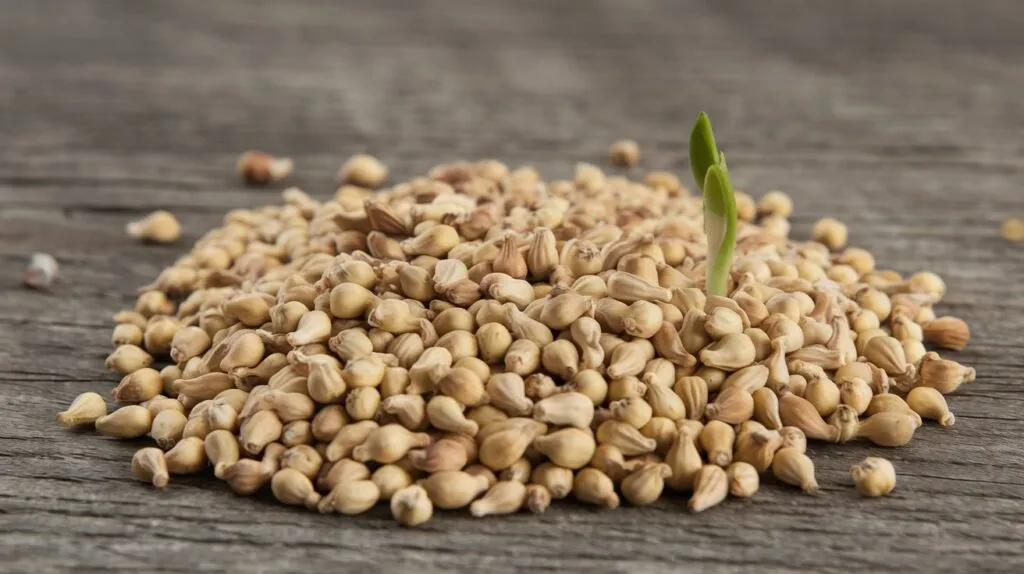Foenegriek: Complete Guide, Health Benefits, Uses, and Side Effects
Foenegriek, scientifically known as Trigonella foenum-graecum, is a small legume plant with immense culinary and medicinal value. It belongs to the Fabaceae family and produces aromatic golden brown seeds and leafy greens that serve as both food and traditional medicine. For centuries, this herb has been used across India, North Africa, and the Mediterranean for promoting wellness, aiding digestion, and enhancing food flavor. Today, it remains a vital part of herbal nutrition and natural therapy.

Botanical Overview
Plant Characteristics
The foenegriek plant typically grows 30–90 cm tall, with trifoliate leaves and pale yellow flowers that produce long seed pods. Each pod carries 10–20 seeds, rich in nutrients and bioactive compounds. The plant thrives in semi-arid regions, making it suitable for cultivation in India, Egypt, and parts of the Middle East.
Scientific Classification
| Category | Detail |
|---|---|
| Family | Fabaceae |
| Genus | Trigonella |
| Species | foenum-graecum |
| Common Names | Foenegriek, Fenugreek, Methi |
| Origin | Mediterranean and West Asia |
Nutritional Profile
Foenegriek seeds are dense in plant protein, soluble fiber, and essential minerals. Their composition supports metabolic health, muscle repair, and hormonal balance.
| Nutrient | Quantity (per 100g) | Key Function |
|---|---|---|
| Protein | 23g | Builds and repairs tissues |
| Fibre | 25g | Regulates digestion |
| Iron | 33mg | Enhances oxygen transport |
| Magnesium | 190mg | Supports energy metabolism |
| Potassium | 770mg | Balances fluid and nerve function |
| Carbohydrates | 58g | Primary energy source |
The seeds also contain bioactive compounds such as diosgenin, galactomannan, and 4 hydroxyisoleucine, known for antioxidant, anti inflammatory, and glucose-regulating effects.
Culinary Uses
Forms of Use
Foenegriek appears in several culinary forms, each with unique flavor and function:
-
Seeds: Dried or roasted, used in curries and spice blends.
-
Powder: Mixed into sauces, soups, or dough for earthy depth.
-
Leaves (Fresh or Dried): Known as methi in Indian cuisine, used in paratha, dal, and stir-fries.
-
Sprouts: Added to salads or used as garnish for nutrient density.
Cultural Significance
-
Indian Cuisine: Integral to spice blends and lentil dishes.
-
Middle Eastern Cooking: Added to breads and herbal teas.
-
North African Diets: Used in tagines and couscous for flavor and aroma.
The distinctive taste a combination of bitterness and sweetness makes it a cornerstone in aromatic cooking.
See More: PLG Supplies: Comprehensive Overview of Products, Markets, and Operations
Valentino Logo: Complete Guide, History, Symbolism, and Evolution
Health Benefits
1. Aids Digestion
The soluble fiber in foenegriek forms a gel like substance that supports gut health and reduces acidity. It promotes smoother digestion and can relieve mild constipation.
2. Supports Blood Sugar Control
The amino acid 4 hydroxyisoleucine enhances insulin activity, while the fiber component helps slow carbohydrate absorption.
Multiple studies indicate significant reductions in fasting glucose and post meal sugar levels with regular intake.
3. Improves Cholesterol Balance
Dietary inclusion may help lower LDL cholesterol and triglycerides, while maintaining or improving HDL levels.
These effects contribute to improved heart health and reduced risk of metabolic syndrome.
4. Enhances Hormonal Balance
Phytochemicals like diosgenin and isoflavones help support natural hormonal function in women.
It’s been used to ease menstrual discomfort and stimulate milk production during lactation.
In men, some research links its extract to improved vitality and testosterone levels.
5. Promotes Hair and Skin Health
Topical applications made from seed paste or oil can help nourish the scalp, reduce dandruff, and add shine to hair.
The anti-inflammatory compounds also support clearer skin and help reduce acne flare-ups.
6. Assists in Weight Management
The high fibre content contributes to longer satiety, preventing overeating. Regular consumption, alongside a balanced diet, may help maintain a healthy body composition.
Cultivation and Agricultural Role
Growing Conditions
Foenegriek is grown as both a food crop and a soil enriching legume.
It requires:
-
Well-drained loamy soil
-
Temperatures between 10–30°C
-
Moderate irrigation
-
Sun exposure for at least 6 hours daily
Agricultural Benefits
As a nitrogen-fixing crop, foenegriek improves soil fertility, reducing dependency on chemical fertilizers. Farmers often use it in crop rotation systems to enhance sustainability.
Usage and Preparation Tips
-
Soaking Method: Soak a teaspoon of seeds overnight; consume the water in the morning for digestive benefits.
-
Foenegriek Tea: Boil crushed seeds with cinnamon or ginger for a detoxifying drink.
-
Topical Paste: Combine powdered seeds with yogurt or coconut oil for natural skincare and haircare applications.
-
In Cooking: Lightly roast seeds before use to mellow bitterness and release aroma.
Storage Recommendations
Keep seeds or powder in airtight jars away from light and moisture. Fresh leaves should be refrigerated and used within three days.
Precautions and Safety
Though natural, excessive intake can cause mild side effects such as gas, bloating, or nausea.
Those allergic to legumes or peanuts should exercise caution.
Pregnant individuals should avoid large medicinal doses, as foenegriek may stimulate uterine contractions.
If under medication for diabetes or blood pressure, consult a physician before use.
Scientific Evidence
Peer-reviewed studies confirm foenegriek’s potential across various health domains:
-
Metabolic Health: Clinical trials indicate improved insulin sensitivity and lipid metabolism.
-
Hormonal Effects: Diosgenin supports estrogenic balance and lactation.
-
Antioxidant Action: Extracts reduce oxidative stress and inflammation markers.
These findings align traditional uses with modern clinical research.
FAQs
Q1. What is foenegriek primarily used for?
It’s used in food, herbal medicine, and natural wellness products for digestion, metabolism, and hormonal support.
Q2. How much foenegriek can I take daily?
Typical amounts range from 1–5 grams of seed powder or 300–600 mg of standardized extract per day.
Q3. Can it help with diabetes?
Yes. The amino acids and soluble fibre aid glucose control and improve insulin response.
Q4. Is it safe to use during pregnancy?
Small amounts in food are safe, but high doses or supplements should be avoided.
Q5. Does foenegriek support hair growth?
Yes, its proteins and natural oils strengthen roots, reduce breakage, and add shine.
Q6. How long before seeing results?
Visible results depend on usage digestive and energy benefits may appear within 1–2 weeks; metabolic changes may take 68 weeks.
Conclusion
Foenegriek (Trigonella foenum graecum) is a time-tested herb with diverse nutritional, medicinal, and agricultural value. Rich in proteins, minerals, and antioxidants, it supports digestion, glucose balance, hormonal health, and skincare. Used moderately, it remains one of the most versatile and evidence-backed botanicals available today. Whether in cooking or wellness routines, foenegriek continues to stand out as a symbol of nature’s balance between flavor and healing.







